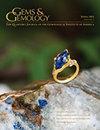宝石地理成因分析方法综述
IF 1.6
3区 地球科学
Q2 MINERALOGY
引用次数: 18
摘要
在宝石学中,“产地”是指宝石矿床的地理位置(Hänni, 1994)。有色宝石的原产地测定始于20世纪50年代的g本文章由计算机程序翻译,如有差异,请以英文原文为准。
A Review of Analytical Methods Used in Geographic Origin Determination of Gemstones
GEMS & GEMOLOGY WINTER 2019 In gemology, “origin” refers to the geographic locality of a gemstone deposit (Hänni, 1994). Origin determination of colored gemstones began with Gübelin and SSEF (both in Switzerland) in the 1950s and with AGL (New York) in 1977 (Schwarz, 2015). Origin determination is of increasing importance in today’s market, and for many gems this information is considered either a value-adding factor or a positive for the salability of a gemstone (Hainschwang and Notari, 2015). Origin determination is often possible because there is a close relationship between the environment of crystallization, especially the mineralogical and chemical composition of the host rock, and the properties of the gemstones that can be studied in the lab, often using sophisticated equipment (Hänni, 1994). In this paper we review the analytical techniques (figure 1) commonly used to characterize gem materials, with a specific focus on geographic origin determination. We also review the physical and chemical properties of corundum and emerald, which have the greatest demand for origin determination. Finally, we provide examples of origin determination of corundum and emerald from the literature to illustrate how these analytical methods are applied to the problem of establishing origin.
求助全文
通过发布文献求助,成功后即可免费获取论文全文。
去求助
来源期刊

Gems & Gemology
地学-矿物学
CiteScore
2.90
自引率
19.20%
发文量
10
期刊介绍:
G&G publishes original articles on gem materials and research in gemology and related fields. Manuscript topics include, but are not limited to:
Laboratory or field research;
Comprehensive reviews of important topics in the field;
Synthetics, imitations, and treatments;
Trade issues;
Recent discoveries or developments in gemology and related fields (e.g., new instruments or identification techniques, gem minerals for the collector, and lapidary techniques);
Descriptions of notable gem materials and localities;
Jewelry manufacturing arts, historical jewelry, and museum exhibits.
 求助内容:
求助内容: 应助结果提醒方式:
应助结果提醒方式:


